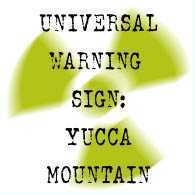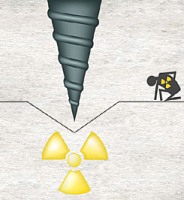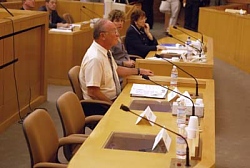
Art Exhibition in Eureka:
Universal Warning Sign: Yucca Mountain
How can you design a warning sign that will not only last 10,000 years,
but will also be comprehended by humans of every culture over the next 10
millennia?
 That is the question tackled by the Universal Warning Sign: Yucca Mountain exhibit on display at the Eureka
County Court House this summer . The exhibit features winning designs of a contest organized by Joshua Abbey,
director of the non-profit Desert Space Foundation. The purpose of the competition was to create “an effective
universal warning sign/permanent marker” to ward off human intrusion at the Yucca Mountain radioactive waste
disposal site. That is the question tackled by the Universal Warning Sign: Yucca Mountain exhibit on display at the Eureka
County Court House this summer . The exhibit features winning designs of a contest organized by Joshua Abbey,
director of the non-profit Desert Space Foundation. The purpose of the competition was to create “an effective
universal warning sign/permanent marker” to ward off human intrusion at the Yucca Mountain radioactive waste
disposal site.
The competition received more than 150 entries from around the world. Entries were made by professional
artists, graduate students, architects, and engineers. Designs were submitted in a variety of media, with ideas ranging
from simple painted signs to complicated technological feats, such as Fabian Winkler’s proposal to mechanically
generate unpleasant heat waves and seismic sound vibrations around Yucca Mountain.
According to Abbey, submissions fell into two general categories. The first includes more technical, practical,
and possibly viable designs; the second “more symbolic commentary on the futility of effectively being able to
achieve a marker that would really work.” The competition was judged by a committee consisting largely of
UNLV art professors.
The competition’s winner, Blue Yucca Ridge, by UCLA School of Architecture graduate
student Ashok Sukumaran, is one of the more symbolic designs. Sukumaran, who received
the competition’s $1,000 prize for best of show, proposed seeding Yucca Mountain
with genetically-altered blue vegetation. While scientists dismissed Sukumaran’s blue
Yucca concept as having “no merit”, judges saw the beauty and symbolism of the idea.
They liked the notion of “one mutated life form acting as a guard over another mutation
[nuclear waste]”, said Abbey.
A potential problem with Sukumaran’s concept, however, is that it might attract curiosity.ity rather than drive people away. Other designs of menacing sculptures and unpleasant effects have the same
problem: the paradox of a keep-out sign. “After all,” said
Abbey, “who can resist a good mystery?”
Many entries, such as that of art student Maho Kishi,
chose to incorporate the common three-triangle yellow
symbol for radioactivity. Her sign portrays a sickened figure
slumping beside a giant drill; both the human figure
and the drilling pit are marked with the radioactive symbol.
Another design by Yulia Hanansen
consists of a the same symbol
constructed three-dimensionally of
stone and stainless steel mesh. Designs
like these, however, assume
that humans 10,000 years into the
future will know what the radioactive
symbol means.
 |
Maho Kishi's Warning Sign |
In reality, just about anything
could happen in 10,000 years:
changing governments, evolving
technologies, and even potentially
crippling major catastrophes (such as
meteor impact, biological warfare,
etc.). A 1995 study by the National
Research Council concluded that it
was impossible to predict either the
risk of intrusion at Yucca Mountain
or the effectiveness of any preventative
measures such as guards or
signs. There are too many variables:
inadvertent versus malicious intrusion,
the level of geologic technology,
and above all, time. The 10,000-year time period
exceeds all recorded human history.
Many contest entries assume that future peoples will
not necessarily be able to interpret past languages and
symbols. They explore other means to keep people away. One example is Andy Griffith’s
design to make Yucca Mountain
look like an active volcano. Ironically
entitled The Great Lie, Griffiths’
submission includes plans for
a false molten core, craters, and
steam vents to be added to the
mountain.
Other entries with a political
tinge include Fate of
the Nevada Seal and
the irreverent Poppin’
Fresh. The first shows
the State Seal deteriorated
into the three-triangle radioactive symbol. The second satirically suggests placing a giant
turkey thermometer in Yucca Mountain that
will pop up when done (after 10,000 yrs).
One of the judges, UNLV
art professor David Hickey,
found irony very appropriate
to the contest. He thought
the contest was “a good
idea” but that the concept of
an everlasting universal sign
was in some sense “a total outrage.” “In a project like this, the
artist's only option really is some kind of irony,” he said.
For his part, Abbey maintains that Universal Signs:
Yucca Mountain plays an important educational role. The
exhibit raises issues of the “implications of the legacy of
nuclear by-products,” Abbey said, as well as the moral and
ethical questions involved. “Whatever marker is chosen
needs to be a monument to our mistakes, not our achievements,”
he said.
(Bulletin of the Atomic Scientists Sept/Oct 2002; Las Vegas City Life
1/17/2002; Las Vegas Sun 1/31/02; Las Vegas Review-Journal 2/8/02)

Nevada still pushing for full-scale cask testing
Nevada government and environmental representatives are urging the Nuclear Regulatory Commission (NRC) to perform
full-scale testing of casks that will be used to haul nuclear waste to Yucca Mountain. The NRC has released a draft
of proposed plans to test casks, but Nevada officials say the tests are too limited and too focused on computer simulation.
Robert Halstead, transportation adviser to Nevada’s Nuclear Waste Project Office, says the NRC should test real-life, fullscale
casks in all of the multiple cask designs to be used. Casks should be tested for leaks, pressure
checks, heat resistance, and be subjected to forceful accident impacts.
NRC’s current plan, to be carried out by Sandia National Laboratories in 2005, only calls
for real-life testing of one rail and one truck cask in two scenarios: a 30-minute fire test, and a
simulated 75 mph crash into an unyielding surface.
In related news, the National Academy of Sciences announced in February that it will conduct
a two-year, $850,000 study of Yucca nuclear waste shipment risks. Funded mostly by
DOE, the NRC, and the Department of Transportation, the study will examine a broad range of issues, including cask testing,
route selection, public perception, and possible health impacts.
(Las Vegas Sun 3/12/03; Las Vegas Review-Journal, 2/22/03)

More Problems with Yucca Mountain’s
Quality Assurance Program
Over the past year, the problematic Yucca Mountain
Quality Assurance Program hit more snags as auditors were
dismissed or reassigned and the Energy Department filed a
stop-work order with its top contractor.
In March, the Department of Energy (DOE) issued a
stop-work order to its program contractor, Bechtel SAIC,
after auditors found flaws in the Yucca Mountain project’s
Quality Assurance program. The order was narrow in focus,
however, and did not bring the project to a halt.
The Yucca “QA” program is designed to keep tabs on
processes of collecting scientific data at the site. Because
the data is used by DOE to support their claim that Yucca
Mountain is a safe place to bury lethal radioactive waste,
the QA program is very important. It needs to be effectively
executed and carefully monitored, especially given
DOE’s rush to meet the December 2004 deadline for their
license application to the Nuclear Regulatory Commission.
Several quality assurance auditors and DOE employees
have found flaws in the program. Three of the fourmember
audit team who found Quality Assurance errors
last winter were subsequently reassigned. One of the auditors,
Don Harris, said he was struck with “disbelief” when
he was given other duties “cleaning up old paperwork.”
Harris had been a Yucca Mountain auditor for 14 years.
 |
Harris and Clark's empty seats at the Yucca Mountain Quality Assurance Hearing in Las Vegas on May 28. |
Harris was one of the key witnesses who promised to
give testimony at a hearing arranged by NV Sens. Reid and
Ensign. Concerned about flaws in the QA program, the
Senators decided to hold a field hearing in Las Vegas on
May 28. Harris, however, failed to show up. So did another
key witness, former DOE Quality Assurance Director
Robert Clark, who was reassigned last year.
The Nevada Senators fear Clark and Harris were silenced
by intimidation from DOE, but the department denies
the implications. “These witnesses can testify at any
time if they choose to do so and we did not stifle anybody,”
said DOE spokesman Joe Davis. The Senators said they
would still try to get Clark and Harris’ concerns on record,
and they are looking into whether DOE has broken any
whistle-blower laws. “There is the potential for some very
serious violations that could potentially affect the quality of
the program at Yucca Mountain, and we need to get to the
bottom of it,” said Ensign.
Bill Belke, former on-site Yucca inspector for the Nuclear
Regulatory Commission, said it is common for
worker concerns to be dismissed or ignored. “This creates
a chilling effect on the project,” Belke said. “People are afraid of retaliation and retribution. It's unhealthy. And it's
not good for the program.”
Other past problems with the Yucca Quality Assurance
program include two stop-work orders, one between 1988
and 1989, and one between 1995 and 1998. In both cases,
concerns were raised about neglected quality controls for
data collection at the site.
(Las Vegas Sun, 4/25/03, 4/28/03; Las
Vegas Review-Journal 5/9/03, 5/29/03)

Goshute Nuclear Waste Storage Site
Rejected, Appealed
On March 10, the Atomic Safety
and Licensing Board ruled that a private
nuclear waste storage facility in
Skull Valley, Utah, could not be built
because of proximity to a nearby Air
Force training range. Although the
waste facility would meet other safety
standards, including earthquake resistance, the board said the
danger of an F-16 crashing into the storage site was too
great.
Private Fuel Storage (PFS), a consortium of eight utilities
that operate nuclear power plants, seeks to build and run
a nuclear waste storage area on the Goshute Indian Reservation,
about 45 miles southwest of Salt Lake City.
 All public and private organizations managing nuclear
materials must apply for a license first from the Nuclear
Regulatory Commission. Applications are granted or denied
by the Commission’s Atomic Safety and Licensing Board.
PFS submitted a license application last year, and a formal
hearing was held in mid-2002 by the licensing board. A
panel of judges heard testimony from PFS, the State of Utah,
and Air Force pilots. PFS argued that a pilot would be able
to steer a plane away from the storage site before any crash
occurred. The Federal regulators, however, thought the
chances were too great. The Air Force flies thousands of
missions a year over the vast Utah Test and Training Range. All public and private organizations managing nuclear
materials must apply for a license first from the Nuclear
Regulatory Commission. Applications are granted or denied
by the Commission’s Atomic Safety and Licensing Board.
PFS submitted a license application last year, and a formal
hearing was held in mid-2002 by the licensing board. A
panel of judges heard testimony from PFS, the State of Utah,
and Air Force pilots. PFS argued that a pilot would be able
to steer a plane away from the storage site before any crash
occurred. The Federal regulators, however, thought the
chances were too great. The Air Force flies thousands of
missions a year over the vast Utah Test and Training Range.
(Associated Press, 3/11/03)
PFS has asked the board to reassess the aircraft analysis.
The utility consortium also submitted a scaled-back waste
storage plan to the board in April. PFS said the smaller site
would decrease the chances of a jet fighter crashing into the
facility.
The original plan called for the storage of 4,000 casks
containing 40,000 metric tons of radioactive waste, but the
new plan proposes storing only 336 casks. Although PFS
intends ultimately to prove its facility will be safe at the
4,000-cask size, it wants the licensing board to grant a temporary
license based on a smaller-size facility.
The Atomic Safety and Licensing Board said the plan
was improperly filed, but that if PFS resubmits the appeal, it
will be expedited.
(Las Vegas Review-Journal, 5/30/03, and Las Vegas Sun, 4/22/03)
|